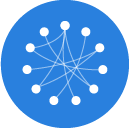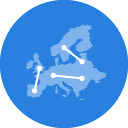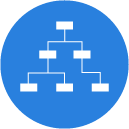 Page top
Page top
 Previous
Previous
 Homepage
Homepage
 Next
Next
Network Diagram
Description
Also known as Network Graph, Network Map, Node-Link Diagram.
This type of visualisation shows how things are interconnected through the use of nodes and link lines to represent their connections and help illuminate the type of relationships between a group of entities.
Typically, nodes are drawn as little dots or circles, but icons can also be used. Links are usually displayed as simple lines connected between the nodes. However, in some Network Diagrams, not all of the nodes and links are created equally: additional variables can be visualised, for example, by making the node size or link stroke weight proportion to an assigned value.
By mapping out connected systems, Network Diagrams can be used to interpret the structure of a network by looking for any clustering of the nodes, how densely nodes are connected or how the diagram layout is arranged.
The two notable types of Network Diagrams are "undirected" and "directed". Undirected Network Diagrams only display the connections between entities, while directed Network Diagrams show if the connections are one-way or two-way through small arrows.
Network Diagrams have a limited data capacity and start to become hard to read when there are too many nodes and resemble "hairballs".
Functions
Anatomy
Tools to Generate Visualisation
Code-based:
amCharts (JS)
AnyChart (JS)
Apache ECharts (JS)
Cosmograph (React)
D3.js Graph Gallery (D3.js)
graph-tool (Python)
Mike Bostock’s Block (D3.js)
Plotly (Python: networkx)
Python Graph Gallery (Python: networkx)
ReGraph (React JS)
R Graph Gallery (R: igraph, ggraph, networkD3)
Sigma.js (JS)
Vega
yFiles
ZingChart (JS)
ZoomCharts (HTML5, JS)
Webapp:
Cosmograph
Flourish
yEd live
Desktop App:
Cytoscape
Gephi






